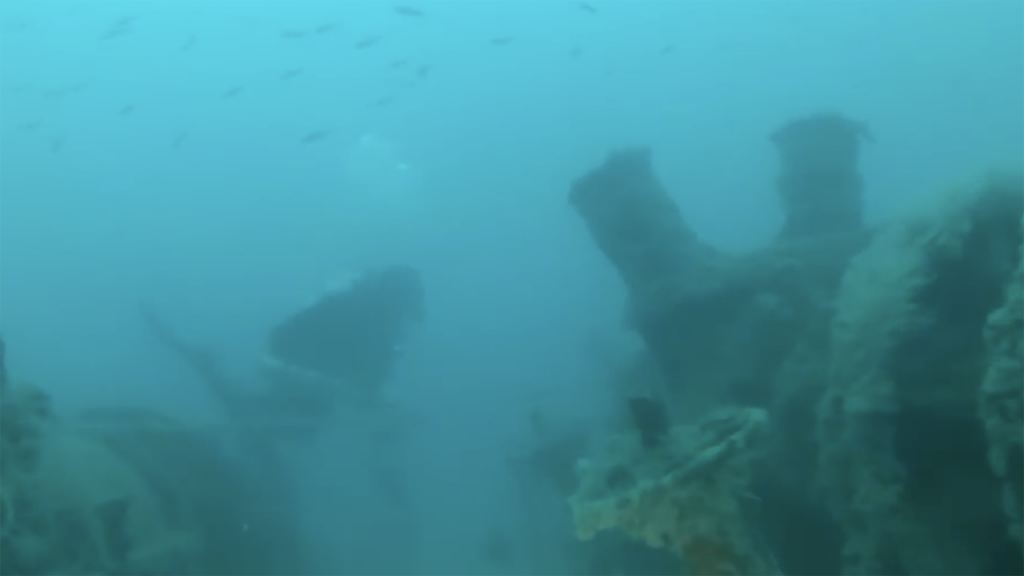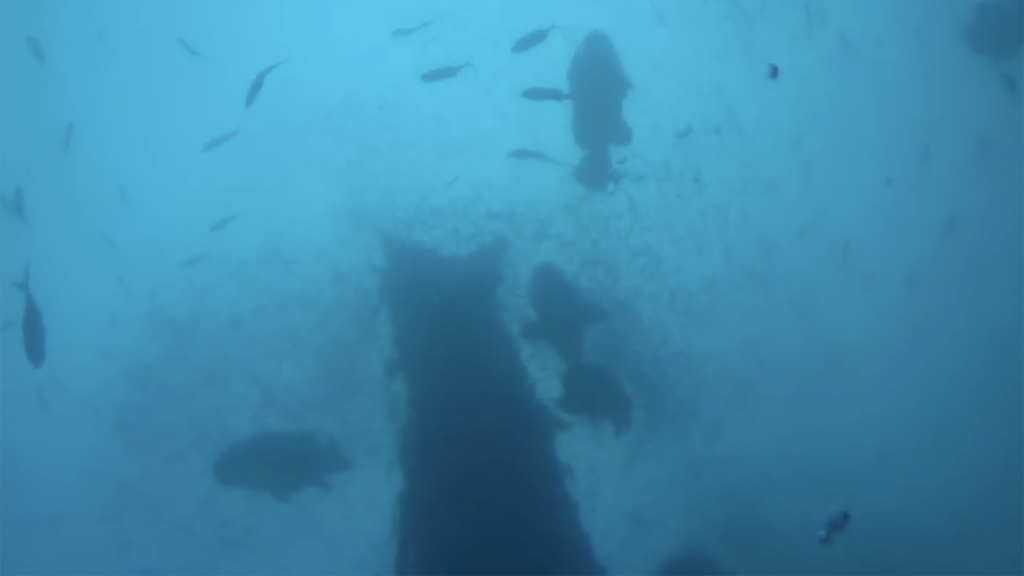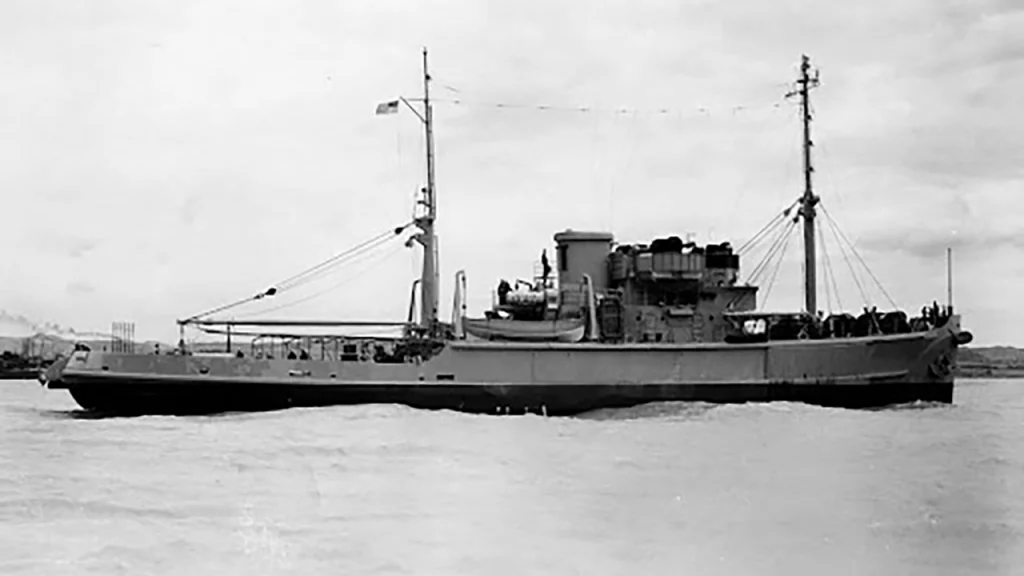Table of Contents

Overall, the USS Curb is viewed as a rewarding dive site for those prepared for its technical challenges, offering a rich experience in terms of both exploration and marine biodiversity.
Article at a Glance
- Historical Significance: The USS Curb (ARS-21) is a Diver-class rescue and salvage ship launched in 1943, serving during World War II before being scuttled in 1983 to create an artificial reef.
- Diving Depth and Accessibility: The wreck lies at a depth of approximately 185 feet, with the shallowest areas around 120 feet, making it suitable for advanced and technical divers only.
- Unique Features: Divers can explore intact compartments, including the pilot house and crew quarters, as well as notable artifacts like large winches, providing a glimpse into the ship’s operational past.
- Abundant Marine Life: The wreck has become a thriving artificial reef, home to diverse marine species such as goliath grouper, tarpon, snapper, and various colorful tropical fish.
- Safety Measures: Due to visibility challenges and potential hazards like entanglement, divers are advised to use proper equipment, conduct thorough dive planning, and dive with experienced guides.
- Dive Shops Offering Trips: Several dive shops in Key West and the Florida Keys, including Captain’s Corner Dive Center and Lost Reef Adventures, offer guided diving trips to the USS Curb.
- Challenging Conditions: Divers should be prepared for strong currents and variable visibility, making it essential to have advanced diving skills and knowledge of emergency protocols.
USS Curb Wreck Location Coordinates and Depth
Depth
The wreck lies at a depth of 185 feet (approximately 56 meters) off the lower Keys, with the shallowest part of the wreck being around 120 feet and the main deck at about 165 feet.
Location Coordinates
- Coordinates:
- Latitude: 24° 26.212′ N
- Longitude: 81° 46.127′ W

What to Scuba Divers Say About This Wreck
- Technical Diving Experience: The USS Curb is regarded as an excellent site for technical divers due to its depth of 185 feet and the opportunity for wreck penetration. Divers appreciate the accessibility of the wreck’s compartments, including crew quarters and the pilot house, which allows for exploration of its structures and equipment, such as winches from its cable-laying days.
- Marine Life: Divers frequently mention the abundant marine life surrounding the wreck. Species such as tarpon, goliath grouper, snapper, and various tropical fish can be observed, contributing to a vibrant underwater experience.
- Visibility and Conditions: While the wreck offers exciting diving opportunities, divers caution that visibility can be limited due to silt and sediment from nearby shipping channels. This can make navigation challenging, especially for those less experienced with deep diving. The presence of fishing lines and nets also poses potential hazards, requiring divers to be vigilant.
- Unique Features: Many divers are drawn to the wreck’s intact condition and the interesting features it offers. The presence of large winches encrusted with marine life and the overall structure of the wreck provide excellent photographic opportunities.
- Recommendations: Due to its depth and the potential for strong currents, the USS Curb is recommended for experienced divers only. It is often suggested as a follow-up dive after a less challenging site, making it suitable for those looking to enhance their technical diving skills.
What Kind of Marine Life Can Be Found on The Wreck
- Goliath Grouper: These large fish are often spotted near the wreck, known for their curious nature towards divers.
- Tarpon: Another common sight, tarpon are sleek and acrobatic fish that add to the vibrant underwater scenery.
- Snapper: Various species of snapper inhabit the area, contributing to the rich biodiversity.
- Hogfish: These fish are often seen around the wreck, adding to the variety of species divers can encounter.
- Cobia: Known for their inquisitive behavior, cobia can often be found swimming near the wreck.
- Pompano: These fish are also part of the marine life that divers can observe at the site.
- Tropical Fish: A wide range of colorful tropical fish inhabit the wreck, enhancing the visual appeal for divers.
- Coral: The wreck itself is encrusted with marine life, including various types of coral, which provide habitat for smaller fish and invertebrates.
Key Information
| Aspect | Details |
|---|---|
| Location | 24° 26.212′ N, 81° 46.127′ W |
| Depth Range | 120-185 feet (36-56 meters) |
| Vessel Type | Diver-class rescue and salvage ship |
| Length | 213.5 feet (65 meters) |
| Beam | 39 feet (11.9 meters) |
| Year Sunk | 1983 |
| Dive Difficulty | Advanced/Technical |
| Notable Features | Intact structure, penetrable compartments |
| Nearby Wrecks | Cayman Salvage Master (1 mile north) |
| Best Diving Season | May to September |
| Typical Visibility | 30-100 feet (9-30 meters) |
| Common Marine Life | Goliath groupers, barracuda, amberjacks |
| Hazards | Strong currents, entanglement risks |
What Makes USS Curb a Unique Diving Experience
Technical Diving Opportunities
The wreck is situated at a depth of 185 feet, with the shallowest parts at around 120 feet. This depth requires divers to have technical diving skills, as it involves decompression diving. The wreck is well-preserved and upright, allowing for safe penetration into various compartments, including crew quarters and the pilot house. The accessibility of these areas is a significant draw for divers looking to explore wreck interiors.
Abundant Marine Life
The USS Curb serves as an artificial reef, attracting a diverse range of marine life. Divers can encounter species such as goliath grouper, tarpon, snapper, and various tropical fish. The warm waters around the wreck support a rich ecosystem, and the fish are often more curious than fearful of divers due to the limited human interaction they experience in this less-frequented dive site.
Unique Historical Background
Originally launched in 1943, the USS Curb was a Diver-class rescue and salvage ship. Its history includes service during World War II and later as a cable layer before being scuttled in 1983 to create an artificial reef. This historical context adds an intriguing layer to the diving experience, as divers can appreciate the ship’s past while exploring its remains.
Challenging Conditions
The wreck’s proximity to a shipping channel means that visibility can be variable, often affected by silt stirred up from the seabed. This creates a challenging environment for divers, requiring careful navigation and awareness of currents. The presence of fishing lines and nets left by sport fishermen adds to the complexity, making it essential for divers to approach the site with caution.
Less Crowded Dive Site
Due to its depth and the technical skills required, the USS Curb does not attract as many divers as other sites, allowing for a more intimate diving experience. This relative isolation means that divers can enjoy the underwater environment without the crowds often found at more accessible dive sites.
What is The Full History of This Wreck
Construction and Commissioning
- Builder: The USS Curb was built by the Basalt Rock Company in Napa, California.
- Launch and Commissioning: The ship was launched on April 24, 1943, and commissioned into the U.S. Navy on May 12, 1944. It was classified as a Diver-class rescue and salvage ship, designed for towing and salvage operations.
World War II Service
- Initial Operations: After commissioning, the USS Curb sailed from San Diego on June 22, 1944. It provided support during the war by delivering battle rafts and participating in towing and salvage operations in the Atlantic Ocean.
- Assignments: The ship operated in various locations, including Argentia, Newfoundland, and Bermuda, where it assisted ships preparing for convoy duties. It returned to Boston on November 16, 1944, after completing its Atlantic operations.
- Transfer to the Pacific Fleet: Following a brief overhaul, the USS Curb was transferred to the Pacific Fleet. It operated in Alaskan waters and completed several towing missions until it returned to San Pedro, California, in August 1946.
Post-War and Decommissioning
- Decommissioning: The USS Curb was decommissioned on December 20, 1946. It was loaned to a private salvage firm, Merritt-Chapman & Scott Corporation, on May 10, 1947, where it continued to serve as a cable layer and salvage vessel for over three decades.
- Stricken from Naval Register: The ship was stricken from the Naval Register on April 30, 1981, marking the end of its service in the U.S. Navy.
Final Disposition
- Sinking as an Artificial Reef: After being prepared for scuttling, the USS Curb was sunk on November 23, 1983, off the coast of Key West, Florida. The wreck now lies at a depth of approximately 185 feet and has become a popular dive site, serving as an artificial reef that supports diverse marine life.

What Historical Features Can Still Be Identified on Wreck
Structural Components
- Intact Hull: The wreck is largely intact, allowing divers to explore its original structure. This includes the ship’s hull, which remains upright on the ocean floor.
- Decks and Compartments: Divers can access various compartments, including the lower crew quarters and the upper pilothouse. The main deck is located at a depth of about 165 feet, with the shallowest parts at around 120 feet.
Artifacts and Equipment
- Winches: The wreck features three large winches on the bow, remnants from its cable-laying days. These winches are now encrusted with marine life and serve as a focal point for divers.
- Pilot House: Although most artifacts from the pilot house, such as the ship’s wheel, telegraph, and compass, have been removed, the structure itself remains, allowing for exploration of the space.
- Hoisting Structures: The upper work deck includes hoisting structures that were used during the ship’s operational days, providing insight into its functionality as a salvage vessel.
Marine Life
The wreck has become an artificial reef, attracting a variety of marine species, which adds to its historical significance. Divers often encounter:
- Goliath Grouper: Known for their size and curiosity, these fish are frequently seen around the wreck.
- Tarpon and Snapper: Various species inhabit the area, making it a vibrant ecosystem.
- Coral Growth: The wreck is encrusted with coral and other marine organisms, showcasing the natural reclamation of the ship by the ocean.
Challenges for Divers
While the wreck offers many exploration opportunities, divers should be aware of the challenges posed by silt buildup and potential hazards like fishing lines. The fine silt can obscure visibility, making navigation tricky, especially in the interior compartments.
What Safety Measures Are in Place for Divers Visiting USS Curb
Technical Diving Requirements
- Advanced Certification: The USS Curb is recommended only for advanced divers with technical diving certifications due to its depth of 185 feet. Divers should be proficient in decompression diving techniques.
- Guided Dives: It is advisable to dive with an experienced guide, especially for those unfamiliar with the wreck or deep diving conditions. Guides can help navigate the wreck and manage potential hazards.
Environmental Considerations
- Visibility Challenges: The wreck is located near a shipping channel, leading to reduced visibility due to sediment and silt. Divers should be cautious of their movements to avoid stirring up silt, which can obscure visibility further.
- Current Awareness: Strong currents can be present at the dive site. Divers should be prepared for varying conditions and plan their dives accordingly, using GPS coordinates to locate the wreck accurately.
Hazards
- Potential Entanglement: The wreck may have fishing lines, nets, and other debris that could pose entanglement risks. Divers should be vigilant and avoid areas where these hazards are present.
- Silt Accumulation: Fine silt can accumulate inside the wreck, making penetration dives challenging. Divers should be cautious when entering compartments and avoid disturbing the silt to maintain visibility.
Equipment Recommendations
- Proper Gear: Divers should use appropriate technical diving gear, including redundancy in equipment (such as extra tanks and regulators) and dive computers to monitor depth and time.
- Safety Stops: Due to the depth, divers should plan for safety stops during ascent to prevent decompression sickness.
Dive Planning
- Pre-Dive Briefing: Conduct a thorough pre-dive briefing to discuss dive plans, potential hazards, and emergency procedures. This is essential for ensuring all divers are aware of the challenges they may face.
- Emergency Protocols: Divers should have a clear understanding of emergency protocols, including ascent procedures and the location of safety equipment.
Dive Shops That Prove Diving Trips to This Shipwreck
- Captain’s Corner Dive Center – Located at 125 Ann St, Key West, FL 33040. Rating: 4.9, Reviews: 315.
- Lost Reef Adventures – Located at 261 Margaret St #6639, Key West, FL 33040. Rating: 4.7, Reviews: 250.
- Finz Dive Center and Tackle Shop – Located at 6021 Peninsular Ave, Key West, FL 33040. Rating: 4.9, Reviews: 205.
- Key Dives – Located at 79851 Overseas Hwy, Islamorada, FL 33036. Rating: 4.7, Reviews: 215.
- Southpoint Divers – Located at 606 Front St, Key West, FL 33040. Rating: 4.5, Reviews: 197.





